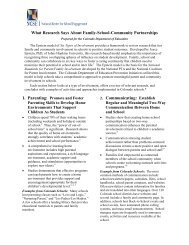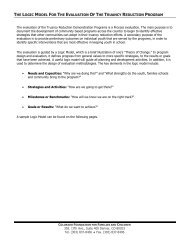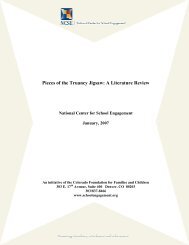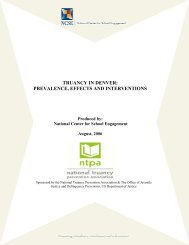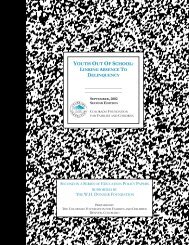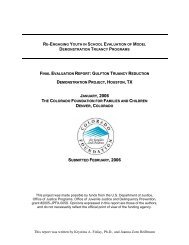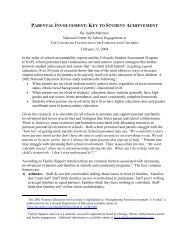Section 1: Academic Achievement - National Center for School ...
Section 1: Academic Achievement - National Center for School ...
Section 1: Academic Achievement - National Center for School ...
Create successful ePaper yourself
Turn your PDF publications into a flip-book with our unique Google optimized e-Paper software.
more com<strong>for</strong>table with it. I questioned whether the expectations the grant held <strong>for</strong> my<br />
students were too high. I watched some of my students get frustrated because while they were<br />
exposed to more of the curriculum than in the past, they were mastering less of it. However, I<br />
still had hope that as a professional I had the necessary skills to reach my students. It was<br />
going to require some additional ef<strong>for</strong>t and energy on my part. I had the second half the year<br />
to focus on my instructional strategies and I could use my surveys to match the curriculum to<br />
the learning needs of my students.<br />
However, that is when the Reading First grant threw a curve ball into this research project.<br />
We attended training in January which outlined what we would teach and <strong>for</strong> all intent and<br />
purpose how we would teach it. The message came across loud and clear that the only way<br />
these kids (school wide, district wide, state wide) could show the necessary growth was if we<br />
followed their standardized way of instruction. Their required ways of instruction were<br />
teacher directed and had limited student interaction. The theory behind the instructional<br />
practices from Reading First was the more explicit and direct the teaching the more<br />
curriculum the students will be exposed to. However, with the student population I have<br />
contact with daily, including the H&HM students, they need the discussion time. They need<br />
time to practice oral language. They need different experiences to develop a context <strong>for</strong><br />
activating background knowledge and connecting them to the curriculum. Finally they need<br />
activities which require them to interact with their peers, not just listen to the teacher talk.<br />
While Reading First was requiring choral responses, some tactile activities, and lots of teacher<br />
directed teaching to keep the pace up, the emphasis was on reading skills, not on interacting<br />
with the curriculum, which was the focus of part of this Web-Based Professional<br />
Development project<br />
While I tried to implement the grant as required, I also consciously made an ef<strong>for</strong>t to use a<br />
little variety from time to time. As the rest of the year progressed, I in<strong>for</strong>mally asked students<br />
to rate what they thought of a particular day’s activities. What I found was that my students<br />
were very polite to me. Although they didn’t say they loved most of the strategies, they didn’t<br />
say they hated them either. Each grade level had their favorite, but those tended to be the<br />
activities that were more interactive and had more direct student involvement. There were<br />
two areas I found most interesting and had nothing to do with what my students could<br />
Action Research to Study Homelessness and High Mobility in <strong>School</strong> Communities 87




